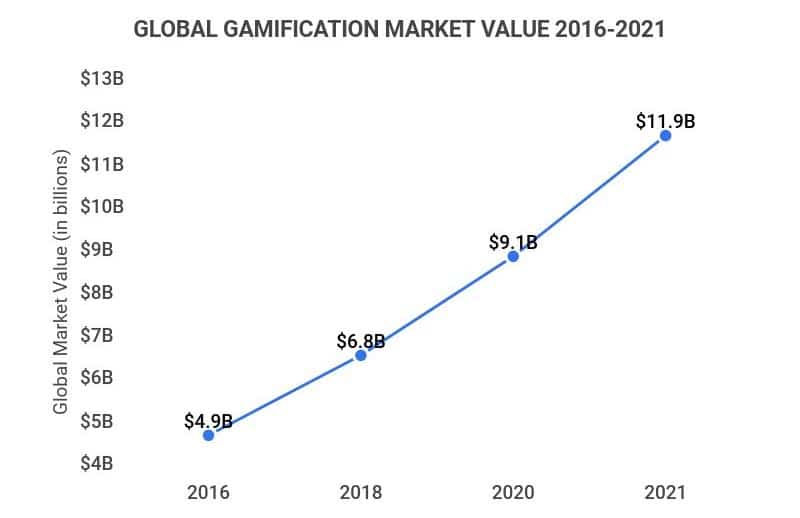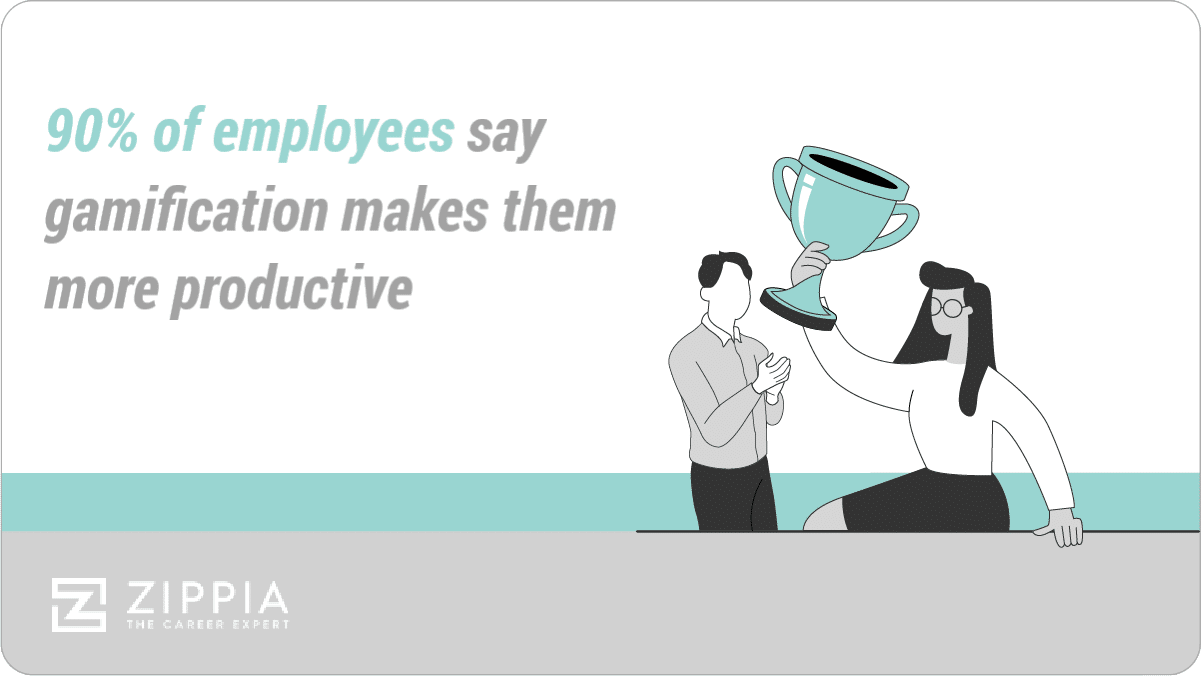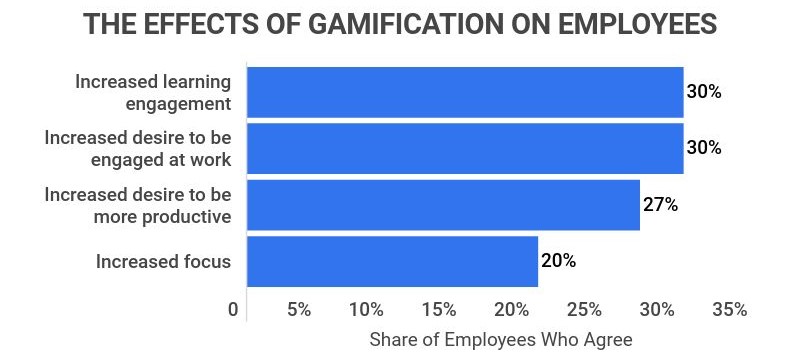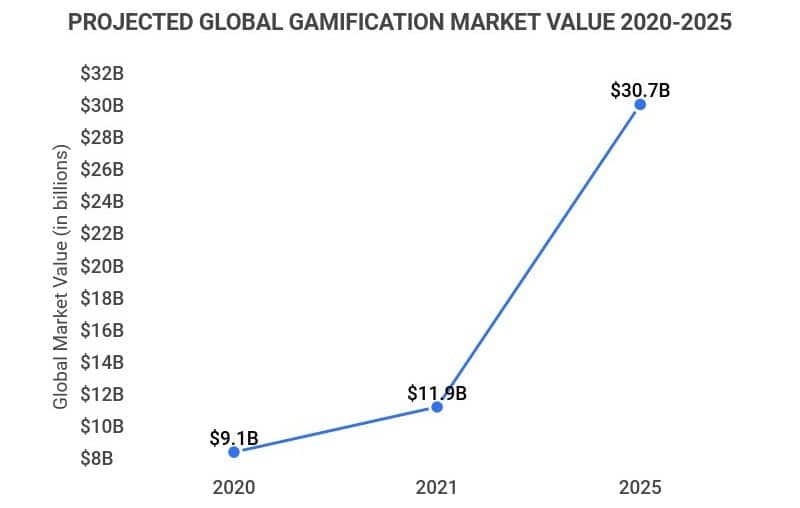- Workplace Statistics
- Time Management Statistics
- Employee Wellness Statistics
- Employment Discrimination Statistics
- Employee Recognition Statistics
- Employee Referral Statistics
- Workplace Violence Statistics
- Gamification Statistics
- Employee Feedback Statistics
- Agile Statistics
- Productivity Statistics
- Meeting Statistics
- Cell Phones At Work Statistics
- Social Media At Work Statistics
- Workplace Injury Statistics
- Workplace Stress Statistics
- Leadership Statistics
- Workplace Collaboration Statistics
- Job Satisfaction Statistics
- Paid Holiday Statistics
- Communication In The Workplace Statistics
- Wasting Time At Work Statistics
- 4-day Workweek Statistics
Research Summary. In recent years, gamification has taken the country and world by storm. More and more successful businesses are incorporating gaming elements into employee training and work experiences to improve productivity and engagement on the job. After extensive research on gamification stats, our data analysis team concluded:
-
90% of employees say gamification makes them more productive at work.
-
On average, employees experience a 48% engagement increase with a gamified work experience.
-
Companies that use gamification are seven times more profitable than those that do not use gamified elements at work—whether with employees or consumers.
-
The North American gamification industry, led primarily by the U.S., is valued at $3.8 billion.
-
72% of people say gamification motivates them to do tasks and work harder on the job.
-
67% of students agree that gamified learning is both more engaging and motivating than traditional classes.
-
The global game-based products and services market is expected to grow at a compound annual growth rate of 12.9% between now and 2025.
For further analysis, we broke down the data in the following ways:
Employee Opinions | Company Results | Benefits | Student Usage | Trends + Projections

Gamification Industry Statistics
-
The global gamification market is currently valued at $11.94 billion.
As of 2021, the total value of the worldwide gamification industry stood at $11.94 billion, an increase of $7.03 billion since 2016. For comparison, as of 2021, the North American gamification market, led by the United States, was valued at $3.8 billion.
Over the next several years, these numbers are expected to increase significantly. Experts expect the international market value will rise by nearly $20 billion, with North America leading the industry.
Global Gamification Market Value 2016-2021
Year Total 2016 $4.9B 2018 $6.8B 2020 $9.1B 2021 $11.9B -
70% of Global 2000 companies use gamification in some way.
As game-based learning improves employee engagement, productivity, and profitability, more and more global businesses are adopting gamification elements in their workplaces. As of now, experts report that as much as 70% of Global 2000 companies (the world’s largest 2,000 companies) use gamification.
Current data suggests that 70% of the U.S. workforce is uncommitted to their work. Meanwhile, companies with engaged employees are 22% more profitable, 21% more productive and have 10% higher customer satisfaction rates. As such, gamification offers many businesses an avenue to success.

Business Gamification Statistics by Employees
-
A whopping 95% of employees prefer a gamified work experience.
Almost all surveyed employees said that they enjoy aspects of gamification at work.
Meanwhile, many job seekers also see gamification as something they look for when looking for employment. One report showed that 78% of surveyed people said that gamification in recruiting would make a company or position more desirable to them.
-
30% of employees claim that game-based learning is more engaging.
While gamification increases the productivty of 90% of workers, it also increases on-the-job engagement levels. For instance, a survey of 500 business workers found that 30% of respondents said that gamification leads to an increased desire to be engaged while at work.
Moreover, that same survey discovered that gamification inspires 27% of workers to be more productive at their job site and helps as much as 20% of people stay focused and avoid distraction at work.
-
61% of U.S. employees receive training with gamification at work.
The majority of American workers receive on-the-job training which incorporates gaming elements. Data illustrates that 83% of workers who receive gamified training feel motivated, while 61% of employees who receive regular training without any gamification elements feel bored.
-
A gamified workspace increases employee happiness by 89%.
A sizeable 89% of surveyed workers said that gamification makes them feel happier and more productive at work. For comparison, an estimated 53% of American workers are unhappy at work. As such, gamification can have significant positive effects.
In addition to increased employee happiness and productivity, a gamified workspace can also help with employee retention, as 69% of employees reported that they would stay at a company for more than three years if they used gamification in some way in the workplace.
-
About one-half of American workers are casual gamers outside of work.
An estimated 80 million white-collar workers in the United States are casual gamers. Moreover, a recent survey found that 24% of all U.S. white-collar office workers play casual video games on the job, and as much as 35% of chief executive officers, chief financial officers, and other top-level executives play casual games at work.
Of the workers who admitted to casual gaming on the job, 65% said they did it at least once a month, with 61% reporting they play games during their lunch hour or break times and 52% claiming they play during their official workday.

Gamification Statistics by Company Results
-
Gamification results in 14% high scores on skill-based assessments.
Overall, adult learners greatly benefit from gamified environments. Gamification results in 14% higher scores on skill-based knowledge assessments and 11% higher scores on factual knowledge tests according to a study by the University of Colorado.
-
Poor planning has led to significant failure when it comes to company gamification.
An estimated 80% of workplace gamification efforts fail to meet a company’s objectives due to poor planning and design and a lack of creativity and meaning.
-
When gamification is used to incentivize workers, customer satisfaction and employee performance improve.
For instance, in one case study, LiveOps, a customer service agency, used gamification to launch an employee app and implement a rewards program to combat high turnover rates and low morale.
After launching the program, it was discovered that participating employees outperformed their peers—they improved by 23% in average call-handle time, raising customer satisfaction by 9%.
Gamification Benefits Statistics
-
Gamification has an overwhelmingly positive effect on user engagement.
Recent studies show that employees experience a 48% engagement increase with gamification.
Moreover, a survey of 500 business workers found that 30% of respondents said that gamification also leads to an increased desire to be engaged while at work. As such, gamification leads to both better engagement and a stronger desire to be engaged in any particular task.
-
Gamification helps to significantly improve information retention.
Incorporating gamification into everyday work and training helps make mundane tasks fun, which, as a result, increases employee skill retention by approximately 40%, according to Gabe Zichermann, author of Gamification by Design.
-
The primary reasons gamification has recently exploded in popularity is due to the increased productivity, profitability, and employee engagement associated with a gamified environment.
According to experts, most business owners, teachers, and managers like gamification because it improves knowledge retention, incorporates practical problem solving into learning environments, presents real opportunities to refine skills with little to no risk, and allows instant and automatic feedback.
Gamification in Education Statistics
-
Gamification has been linked to a 50% improvement in student productivity.
With 80% of U.S. workers reporting that gamified learning experiences are more engaging compared to typical training exercises, it’s no surprise that gamification also improves productivity by 50%.
-
In some instances, gamification can improve student test scores by as much as 34%.
In one case study, an elementary school math teacher found that after four months of implementing math games into his student’s learning curriculum, average test scores increased from 49% to 83%—a 34% increase.
Due to the overwhelming success rates that gamification has on students’ learning and test scores, it’s estimated that roughly 75% of all K-8 teachers in the United States use digital games, to some extent, for instruction.
-
67% of U.S. students prefer gamified learning experiences.
Nearly 70% of students prefer gamified classes and learning experiences over traditional education methods, citing increased motivation and engagements as the primary factors drawing them to gamified learning.
Trends and Predictions in the Gamification Industry
-
The global gamification industry is predicted to grow at a compound annual growth rate of 27.4% over the next several years.
Between 2020 and 2025, experts predict the international gamification market will grow at a compound annual growth rate, or CAGR, of 27.4%, increasing from $9.1 billion in 2020 to an estimated $30.7 billion by 2025.
During this time, gamification is expected to yield a higher return on investment with the substantial market growth fueled by employee engagement and performance.

-
Gamified learning is expected to be valued at $25.7 billion by 2025.
Gamification in education is expected to grow at a compound annual growth rate of 14% between now and 2025. At that rate, the market will be worth $25.7 billion in 2025—$12.3 billion more than the current market value.
-
Over the last five years, the global gamification market has grown by $7.03 billion.
Gamification has grown rapidly over the past several years. In 2016, the international gamification market was valued at $4.91 billion. Meanwhile, the most recent numbers illustrate a roughly 143% increase, as the market is now valued at $11.94 billion.
Gamification Statistics FAQ
-
How effective is gamification?
Gamification is highly effective in motivating employees and students and increasing productivity and engagement. In business, gamification can be directly linked to increased profitability and efficiency, drastically improved customer and employee experiences, and better worker retention rates.
-
Gamification is one of the most popular learning and business tools in the United States and worldwide. Internationally, 70% of global 2000 companies use gamification in some way.
Across the U.S., data shows that 50% of startups use gamification. Moreover, in the United States, it’s estimated that 80% of American households own at least one gaming device.
-
How big is the gamification industry?
The gamification industry is a multi-billion dollar operation. Currently, the global gamification market is valued at $11.94 billion, increasing $7.03 billion since 2016. For comparison, as of 2021, the North American gamification market, led by the United States, was valued at $3.8 billion.
Over the next several years, the gamification industry is expected to explode. Experts expect the international market value to rise by nearly $20 billion, with North America leading.
-
What makes gamification successful?
The overwhelming success of gamification is directly linked to the increased motivation, engagement, and productivity that results from students and employees interacting, working, and learning in a gamified environment.
A whopping 95% of surveyed employees said that they enjoy aspects of gamification at work—these fun aspects of gamification are said to increase employee skill retention by up to 40%. Moreover, an impressive 30% of employees also claim that game-based learning is more engaging, which leads to higher gamification success rates.
-
According to the numbers, yes, gamification is the future. As more and more people and businesses realize and profit from the advantages of gamification, the industry continues to grow significantly. As it stands now, 70% of global 2000 companies and roughly 75% of K-8 teachers in the United States use gamification in some way.
With the global gamification market projected to grow at a compound annual growth rate of 14% between now and 2025 and the global game-based products and services industry expected to grow at a compound annual growth rate of 12.9% between now and 2025, the future of business and learning could very well be gamification.
-
What problem does gamification solve?
The problem that gamification solves is making essential activities and tasks less boring and more engaging. Gamification attempts to help students, trainees, or employees enjoy the gamified reward system that surrounds the task, which makes it seem less unpleasant to perform.
By solving the problem of low engagement, gamification also boosts productivity for most people. The reason is simple: people generally complete tasks faster and are less distracted when they’re actively engaged with the activity. So in a sense, gamification “solves” two problems: low engagement and low productivity.
-
How is gamification used in HR?
Gamification is used in HR primarily to help recruit, onboard, and train employees. Some application processes involve gamified elements like personality quizzes that help understand work-related behaviors and employee referral policies sometimes work on points systems.
Gamification plays an even larger role in onboarding employees. Many onboarding programs involve a lot of videos on company policies, and it’s very common to have quizzes at the end to ensure comprehension. The sense of progression, easy wins, and achievement is great for increasing retention rates and making new hires feel more confident on their first day.
Finally, employee training beyond the onboarding experience often relies on gamification. Walmart, for example, uses a computer game to ensure that their employees have a good working knowledge of their safety policies.
-
What are some potential problems with using gamification for training?
Some potential problems with using gamification for training include creating an unhelpful incentive system and turning off employees who don’t enjoy games.
The most common complaint about gamified tests following training videos is that they don’t really assess whether the person understood the videos, but rather their ability to answer fairly common-sense, multiple-choice questions. The incentive becomes passing the quiz, completing the game, or getting a high score, rather than gaining actual working knowledge of their job.
Furthermore, some people prefer a more traditional training program with straightforward instructions. For them, gamification might be an annoying and unwelcome extra hurdle that actually disincentivizes the completion of training. That’s why it’s important to make gamification just one part of the HR puzzle, rather than the entire package.
Conclusion
In recent years, gamification has taken the world by storm, and the industry only continues to grow. Current data illustrates that high student and employee success rates and profitability are closely associated with gamified working and learning environments. Such environments directly increase motivation, happiness, productivity, and efficiency.
Meanwhile, for businesses across the nation, gamification remains a lucrative market. Approximately 90% of employees say gamification makes them more productive at work, allowing companies that use gamification techniques to be up to 7 times more profitable than those that do not incorporate gamified elements into their workplaces.
With the global gamification market expected to rise by nearly $20 billion, the future of gamification certainly looks bright.
References
-
Globe Newswire. “Gamification Market To Reach More Than $32 Billion By 2025: Analysis By Size, Revenue, Recent Developments, Opportunities, Key Trends and Business Strategy.” Accessed on November 27, 2021.
-
Statista. “Gamification Market Value Worldwide 2016-2021.” Accessed on November 27, 2021.
-
Markets and Markets. “Gamification Market By Component, Deployment, Organization Size, Application, End-User, Vertical and Region: Global Forecast to 2025.” Accessed on November 27, 2021.
-
Fortune Business Insights. “Gamification Market Size, Share and Industry Analysis.” Accessed on November 29, 2021.
-
Crewhu. “Training With Gamification.” Accessed on November 29, 2021.
-
Medium. “How Gamification In The Workplace Impacts Employee Productivity.” Accessed on November 30, 2021.
-
Imaginovation Insider. “How Workplace Gamification Improves Employee Productivity (With Examples).” Accessed on November 30, 2021.
-
Game Developer. “Survey Finds Execs Gaming On Office Time.” Accessed on November 30, 2021.
-
AnswerHub. “Increase Employee Productivity With Gamification.” Accessed on November 30, 2021.
-
Niel Patel. “How To Use Gamification For Better Business Results.” Accessed on December 1, 2021.
-
Softtek. “70% Of The Companies In The Global 2000 List Already Use Gamification.” Accessed on December 1, 2021.
-
Grand View Research. “Video Game Market Size, Share Trends Analysis Report By Device, By Type, By Region, And Segment Forecasts, 2020-2027.” Accessed on December 1, 2021.
-
Projections. “The Power Of Gamification For Organizational Development.” Accessed on December 2, 2021.
-
My Cred. “The Future Of Gamification In Major Industries For Next Five Years (2020-2025).” Accessed on December 2, 2021.
-
Technology Advice. “The Influence Effectiveness of Gamification in eLearning.” Accessed on December 3, 2021.
-
Bravon. “Benefits Of Gamification In Learning.” Accessed on December 3, 2021.
-
Intuition. “Learning Via Gamification: Latest Data, Stats Trends.” Accessed on December 3, 2021.
-
Education Week. “Do Digital Games Improve Children’s Math Skills?” Accessed on December 3, 2021.
-
Precedence Research. “Gamification Market.” Accessed on February 23, 2023.
- Workplace Statistics
- Time Management Statistics
- Employee Wellness Statistics
- Employment Discrimination Statistics
- Employee Recognition Statistics
- Employee Referral Statistics
- Workplace Violence Statistics
- Gamification Statistics
- Employee Feedback Statistics
- Agile Statistics
- Productivity Statistics
- Meeting Statistics
- Cell Phones At Work Statistics
- Social Media At Work Statistics
- Workplace Injury Statistics
- Workplace Stress Statistics
- Leadership Statistics
- Workplace Collaboration Statistics
- Job Satisfaction Statistics
- Paid Holiday Statistics
- Communication In The Workplace Statistics
- Wasting Time At Work Statistics
- 4-day Workweek Statistics





